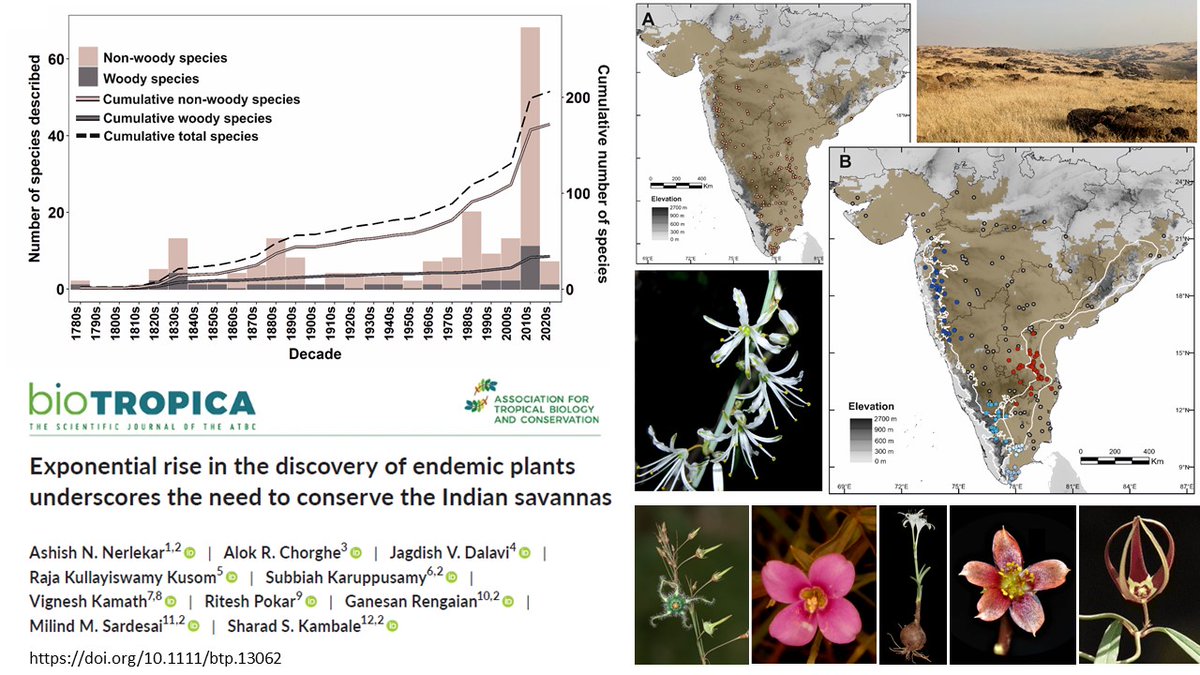
🌟Publication alert!🌟
Botanists are discovering several endemic plants in the Indian savannas—ecosystems long misinterpreted as wastelands of low conservation value.
Article link (DM for access if needed): onlinelibrary.wiley.com/doi/10.1111/bt…
Read on for a summary. 1/n
Botanists are discovering several endemic plants in the Indian savannas—ecosystems long misinterpreted as wastelands of low conservation value.
Article link (DM for access if needed): onlinelibrary.wiley.com/doi/10.1111/bt…
Read on for a summary. 1/n

A huge proportion of biodiversity remains undescribed globally, and this biodiversity knowledge shortfall is disproportionately > for tropical savannas compared to tropical forests 2/n
Some of this is coz tropical savannas have been misinterpreted as secondary ecosystems having negligible endemics. Eg. Malagasy savannas were once thought to be t most degraded landscapes on earth with no endemics. Recent studies now show tht 40% of Malagasy grasses r endemic 3/n
Like Madagascar, Indian savannas have also been thought to be degraded forests. The legacy of colonial era timber-oriented forestry continues to value trees over grasses and consequently devalues savannas over forests.
Read @abi_vanak s piece on this:
bit.ly/3FNtdWJ 4/n
Read @abi_vanak s piece on this:
bit.ly/3FNtdWJ 4/n
Speaking of colonial legacy, the graphs in the article have a colour palette inspired from the Crawley house in @DowntonAbbey #ggplot2 5/n 



One assumption underlying the devaluation of Indian savannas against Indian forests is that the savannas contain negligible plant endemics given their supposed anthropogenic origins 6/n
We test this assumption by performing a systematic review of plant endemism in the Indian savannas. Further, we also try to understand the spatio-temporal discovery patterns of the endemics 7/n
We found that the Indian savannas contain at least 206* endemic plants & 43% of these were described on or after the year 2000.
*+A dozen more have been described while the paper was in review
Species list is in the supplement. 9/n
*+A dozen more have been described while the paper was in review
Species list is in the supplement. 9/n
The most number of endemic species in our list belonged to the Ceropegia-Brachystelma clade (Apocynaceae) such as this gorgeous looking Brachystelma penchalakonensis described from Andhra Pradesh: bit.ly/3fQMFY4.
Pic credits @AlokChorghe 10/n
Pic credits @AlokChorghe 10/n

From where within India were all these endemics being described? We found that there were two species discovery hotspots or clusters—eastern edge of the Western Ghats Mountains (a global biodiversity hotspot) & the Eastern Ghats Mountains. 11/n 

We also show that most plant endemics that await discovery will likely be short statured (so we need more/better trained botanists), range restricted (therefore inherently threatened with risk of extinction), and located at higher latitudes and elevations 12/n
Ours is the first large-scale analysis to synthesize the levels and spatio-temporal patterns of plant endemism in Indian savannas. We hope this data leads to more biodiversity research in this understudied landscape 13/n
Key takeaways: 1) Contrary to the widely held assumption, Indian savannas house considerable endemics and tons of more species await description.
2) Conservation prioritization efforts should focus on the 2 species discovery hotspots
14/n
2) Conservation prioritization efforts should focus on the 2 species discovery hotspots
14/n
3) Conservation approaches for forests n savannas r diffrnt-planting trees harms savanna endemics
4) Finally, moving away from the colonial mindset, understanding that Indian savannas r ancient biodiverse ecosystems is the🔑to preserving India's fast-vanishing biodiversity 15/n
4) Finally, moving away from the colonial mindset, understanding that Indian savannas r ancient biodiverse ecosystems is the🔑to preserving India's fast-vanishing biodiversity 15/n
Publishing with @Biotropica—a venue I value for several reasons—has been an amazing experience. @theATBC @jennifer_pow you are doing an amazing job!
PS-I wish @Biotropica retained its signature Samanea tree on the green band layout as opposed to homogenized Wiley templates 16/n
PS-I wish @Biotropica retained its signature Samanea tree on the green band layout as opposed to homogenized Wiley templates 16/n
Shout out to folks who helped improve the manuscript: @itatiVCS (I owe you one!), @lars_brudvig, @crwarneke, Emily Conway, @FoggyIdeas, @RileyPizza, @catano_chris, @AshwinW10, @noopurborawake, @AvishkarMunje, @ruskmelon_007 17/17
• • •
Missing some Tweet in this thread? You can try to
force a refresh









